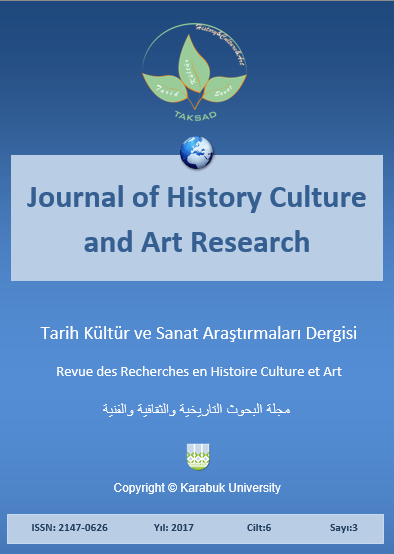The Smart Residential Complex Effect on Personality Formation of Children
DOI:
https://doi.org/10.7596/taksad.v6i3.992Anahtar Kelimeler:
Smart residential complex- Building automation- BMS- Environmental psychology- Child behavior- Management.Özet
The interaction between human beings and the environment has been a question of all times; however, the Industrial Revolution has begun to change its way. It can be seen that the human beings were a part of their environment in the past, but now with the advancement of knowledge and technology, the man can dominate in their environment. But today, the man’s needs should be well known about the interaction with the natural environment and with respect to the position of the residential complexes in the modern society, these buildings are designed to create the psychological comfort and the formation of the personality. The authors of this paper believe the mentioned event will be happening in the future generation of the buildings. These buildings will be equipped with smart automation system for all their activities. This research conducted by grounded theories about the explanation of the smart residential complexes equipped with the BMS, which can be effective for shaping the managerial character of the children in their future.
Referanslar
Afroz, G. (2010). Discussions in the psychology and education of children and adolescents. Islamic Culture Publications Office. Tehran.
Afshari Basir, N. & Afshari Basir, R. (2010). Smart Buildings, a Step toward New Technology in the Construction. Second International Conference on Architecture and Structural Engineering, Tehran: Tehran University.
Alvani, M. (2015). General Management. Ney Publishing, edition 52. Tehran.
Aramis Smart Technology Development Co.
Azmodeh, M. (2009). Garden-Museum Design of Children in the Shahrakeh Gharb in Tehran. Thesis. Tehran: Tehran University.
Behvarzan Smart Technology Development Co.
Daneshpur, Syed Abdul Hadi. (2000). Recognition of identity concept in the public space of the city (the street). Urbanism Doctoral Dissertation Planning, Faculty of Fine Arts. Tehran: Tehran University.
Ghare Begloo Mino; Eynifar, Alireza & Izadi A. A. (2013). To promote children's interaction with the place of the outdoor spaces in the residential complexes (case study of the three types of the residential outdoor space in the Tabriz city). The Journal of Fine Arts. Architecture and Urbanism, Volume 18, Issue 2.
Hariri, R. (2009). The principles of energy efficiency in the industrial buildings, management period of energy. The International Energy Research Institute of the Ministry of Oil.
Hossein Zadeh, R. & Soltanzadeh, H. (2013). The flexibility of the environment and its impact on the behavior of orphans, The National Conference of Humanistic Architecture and Urbanism.
Jalili, M. (2010). Analytical review on the environment concept in the psychology literature of the of environment (Nature of the environment). Manzar, Issue 12.
Jameie, Sarah & Balesh Zar, N. (2015). Examines the Impact of the Responsive Skeletal Environment Design for Children's Development and Their Social Relations From the Perspective of Environmental Psychology. Dubai-UAE: International Conference on Science and Engineering.
Mir Hadi, Touran (2003). What is in the long run of the child? The Internal Journal of the Child Book Council, issue 41, Tehran: Space, Architecture.
Moini, Mahmoud & Jalali, A. (2015). The Impact of Form and Color of the Environment in the Increase of Children's Creativity. National Conference of the tourism culture and urban identity.
Molly, Russell Smart (1984). Growth Psychology of Children and Adolescents, translation: Seif, S., Tehran: Vahid Publication.
Moravati, A.; Bahari, T. & Firozeh Far, S. (2014). The Investigation of the Optimizing Ways to Energy Consumption in Smart Buildings. The Third International Conference on new approaches in Energy Conservation.
Osareh, A.R. (2013). Current functions of our education in religious training. Researches Papers of the Religious Education Pathology Conference on Education, vol. 2, Tehran: Mehrab Ghalam.
Piaget, Jean; Barbl, Inhilder & Tofigh Zinat (2006). Child Psychology. Tehran: Ney Publiction.
Rappaport, Amos (2005). Meaning of the Built Environment, an Approach of the Nonverbal Communication. Translation of Farah Habib. Tehran: Publication of the processing and urban planning Co.
Reza Zadeh, R. (2011). Perceptual-behavioral crisis in the urban area. Municipal Magazine, Issue 23.
Rezaeian, A. (2015). Principles of Management. Publish of and Editing and Study Organization of Humanities Science Books of the Universities, (Samt), Tehran: twenty-seventh edition.
Rezai, D.; Nahavandi, M. & Zendeh Shahvar, M. A. (2013). Providing Solutions to Energy Conservation in Residential Building’s Architecture and Investigate the Smart Systems. The first national conference of architecture and sustainable urban space.
Sanati Tarah, M. (2010). Smart Building Management System. Journal of Technology and Executive Director's Message.
Shahcheraghi, A. (2009). Cognitive process analysis of the Persian garden environment, according to the theory of ecological psychology. The Identity of the City, Issue 5.
Zareie, Ahmad & Gholami Shiri, Hamid (2012). The Role of Positivism Role in Enhancing Effective Serotonin to Create of the Emotion and Vitality Balance and Effective Strategies in Promoting Positive Thinking. First period of happiness and joy Conference. Tehran.
İndir
Nasıl Atıf Yapılır
Sayı
Bölüm
Lisans
Tarih Kültür ve Sanat Araştırmaları Dergisi'nde yayımlanan tüm çalışmalar Creative Commons 4.0 CC-BY lisansı ile lisanslanmıştır.
Bunları yapmakta özgürsünüz:
- Bu eseri her boyut ve formatta paylaşabilir — kopyalayabilir ve çoğaltabilirsiniz.
- Materyalden Adapte et — karıştır, aktar ve eserin üzerine inşa et
- her türlü amaç için, ticari amaç da dahil
Alttaki şartlar altında:
Atıf — uygun bilgiyi, lisansa linki, and ve değişiklik yapıldıysa değişiklik bilgisinivermelisiniz. Sizi veya kullanımınızı lisansörün onayladığı bilgisini içermemek kaydıyla, size uygun şekilde bu işlemleri gerçekleştirebilirsiniz.
AynıLisanslaPaylaş — Eğer materyali karıştırdınızsa, aktardınızsa ya da materyalin üzerine çalıştınızsa, ancak aynı lisans ile dağıtabilirsiniz.
- Ek sınırlamalar yoktur — Lisansın izin verdiği hakları başkaları üzerinde kanunlarla ya da teknolojiyikullanarak sınırlayamazsınız.







